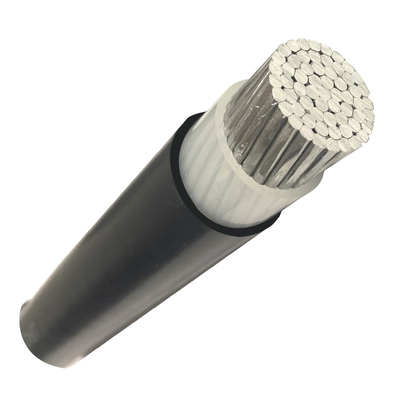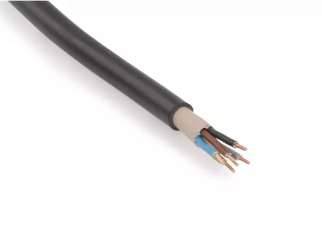Seleccionar el tipo correcto de aislamiento y cubierta para el cable de aluminio es fundamental para garantizar una transmisión de energía segura y eficiente. En este artículo, analizamos las diversas opciones disponibles para los tipos de revestimiento y aislamiento, y los factores a considerar al elegir la mejor opción para su aplicación en particular.
Tipos de aislamiento del cable de aluminio duradero
Cables de aluminio existen varios tipos de aislamiento, cada uno con sus propias ventajas e inconvenientes. Los tipos de aislamiento más comunes para los cables de aluminio son:
1.1 Cloruro de polivinilo (PVC)
El PVC es un tipo de aislamiento popular para los cables de aluminio porque es relativamente barato y proporciona un buen aislamiento eléctrico. Sin embargo, el PVC no es tan duradero como otros tipos de aislamiento y puede volverse quebradizo con el tiempo.
1.2 Polietileno reticulado (XLPE)
El XLPE es un tipo de aislamiento más duradero que el PVC y suele utilizarse en aplicaciones en las que los cables estarán expuestos a condiciones duras. El XLPE también es más resistente a los productos químicos y a las altas temperaturas que el PVC.
1.3 Caucho etileno propileno (EPR)
El EPR es otro tipo de aislamiento duradero que suele utilizarse en aplicaciones de alta temperatura y alta tensión. El EPR también es más resistente al ozono y a la radiación UV que el PVC y el XLPE.
_1661584667319.jpg)
Aluminio Tipo de cubierta del cable
Además del aislamiento, el tipo de cubierta de un cable de aluminio desempeña un papel importante en su rendimiento y durabilidad. Los tipos más comunes de cubiertas para cables de aluminio son:
2.1 PVC
El PVC es un tipo de cubierta habitual para los cables de aluminio porque es relativamente barato y tiene un buen aislamiento eléctrico. Sin embargo, el PVC no es tan duradero como otros tipos de cubierta y puede volverse quebradizo con el tiempo.
2.2 Polietileno (PE)
El PE es un tipo de cubierta más duradero que el PVC y suele utilizarse en aplicaciones en las que el cable estará expuesto a condiciones duras. El PE también es más resistente a los productos químicos y a las altas temperaturas que el PVC.
2.3 Baja emisión de humos y sin halógenos (LSZH)
El LSZH es un material de cubierta ignífugo que emite muy poco humo y no produce halógenos tóxicos cuando se expone al calor o al fuego. Por razones de seguridad, este tipo de cable resistente al fuego se utiliza habitualmente en edificios industriales, comerciales y residenciales, así como en sistemas de transporte.
Factores a tener en cuenta al elegir el tipo de aislamiento y la funda
Hay varios factores que deben tenerse en cuenta a la hora de elegir el tipo de aislamiento y cubierta para su cable de aluminio, entre ellos:
3.1 Temperatura de trabajo
La temperatura de funcionamiento del cable determinará la temperatura máxima a la que el aislamiento y la cubierta pueden funcionar con seguridad. Por ejemplo, el PVC tiene una temperatura máxima de funcionamiento de 60 °C, mientras que el XLPE y el EPR pueden soportar temperaturas de hasta 90 °C.
3.2 Tensión nominal
La tensión nominal del cable determinará la tensión máxima a la que el aislamiento y la cubierta pueden funcionar con seguridad. Es importante seleccionar un tipo de aislamiento y cubierta con una tensión nominal igual o superior a la del cable.
3.3 Condiciones medioambientales
El entorno en el que se instale el cable también influirá a la hora de determinar el mejor tipo de aislamiento y cubierta. Por ejemplo, si el cable va a estar expuesto a radiaciones químicas o UV, es importante elegir un tipo de aislamiento y cubierta que pueda soportar estas condiciones.
3.4 Normas de seguridad e incendios
Por ejemplo, si el cable se va a instalar en un edificio o en un sistema de transporte, puede ser conveniente utilizar un tipo de cubierta resistente a las llamas, que emita un humo mínimo cuando se exponga al calor o al fuego y que no contenga halógenos tóxicos, como AWM UL2464.
3.5 Durabilidad y mantenimiento
A la hora de seleccionar el tipo de aislamiento y cubierta, también deben tenerse en cuenta la durabilidad y los requisitos de mantenimiento del cable. Por ejemplo, el XLPE y el EPR son más duraderos que el PVC y pueden requerir menos mantenimiento a lo largo de la vida útil del cable.
En conclusión
Seleccionar el tipo correcto de aislamiento y cubierta para el cable de aluminio es fundamental para garantizar una transmisión de energía segura y eficaz. Los tipos de aislamiento más comunes para los cables de aluminio incluyen PVC, XLPE y EPR, mientras que los tipos de cubierta más comunes incluyen PVC, PE y LSZH. A la hora de seleccionar la mejor opción para su aplicación concreta, es importante tener en cuenta factores como la temperatura de funcionamiento, la tensión nominal, las condiciones ambientales, las normas de seguridad y contra incendios, y la durabilidad y el mantenimiento. Con el tipo correcto de aislamiento y cubierta, su cable de aluminio podrá rendir al máximo, proporcionando una transmisión de energía fiable y eficaz durante años.
Información adicional
A la hora de elegir el tipo de aislamiento y cubierta para su cable de aluminio, asegúrese de consultar a un experto que pueda orientarle en la dirección correcta. También es importante consultar las normas de seguridad e incendios pertinentes, que pueden variar según el lugar, la aplicación y el sector industrial. Asegúrese siempre de que el tipo de aislamiento y cubierta que elija cumpla los requisitos del Código Eléctrico Nacional (NEC) y otras normas pertinentes de su zona. Con el tipo correcto de aislamiento y cubierta, los cables de aluminio proporcionarán la transmisión segura, fiable y eficiente de energía que es esencial para cualquier sistema eléctrico.
Anyte Cable no solo desarrolla y fabrica cables estándar de alta calidad, sino que también brinda excelentes soluciones de acuerdo con sus necesidades y aplicaciones de productos. Bienvenido a su consulta en cualquier momento.
Productos relacionados





